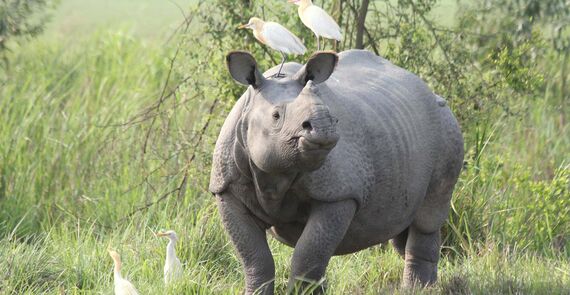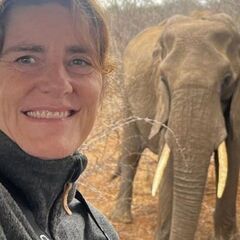A Melting Pot of Magnificent Scenery, Abundant Wildlife and Incredible Culture
With an area of more than 3 million square kilometres, India is a huge country. It is also one of the world’s most populated countries, with some 1.3 billion inhabitants. The Indian peninsula, which largely consists of India, is regarded by many as a sub-continent in itself. As a holiday destination India is perhaps best known for its exciting and colourful culture and its many world famous historical buildings such as the Taj Mahal. The vast majority of tourists visiting the country come to experience these things, very few of them spend any time exploring India’s fantastic nature and wildlife, which is a real shame. As safari specialists we have chosen to focus on the country’s incredible animal life, but our tours naturally also visit some of the biggest cultural attractions that lie along the route taken by our safaris.
The Country of The Jungle Book and Rikki-Tikki-Tavi
In the area around the town of Nagpur in central India, which was Kipling’s home and provided the inspiration for the Jungle Book, you can find most of India’s very best “tiger-parks” such as Bandhavgarh, Kanha, Pench and Tadoba, while Ranthambore lies further to the west. All these parks also have good numbers of both bears and leopards. Naturally they are also home to the many animals preyed upon by the big carnivores such as deer and wild boar, and have fantastic numbers of birds. Towards the north at the feet of the Himalayan mountains you can also find fantastic national parks, of these Kaziranga to the east of the country has good populations of Asian elephants, Indian rhinoceros and water buffalo. Both the culture and the wildlife here, which includes gibbons and many spectacular birds, clearly show the influence Far East Asia has on this area. In western India, such as the area around Gir National Park the environment is more arid and the animal life very different. Asiatic lions, leopards, hyenas, wolves and foxes are the most dominant predators, while a number of antelope species act as prey. In the more open landscapes of the west it is easier to see the many birds, especially the birds of prey.
Modern Infrastructure
There are good flight connections to many Indian cities from Europe, while the country also has a good network of railways and domestic flights. The cost of travelling is very reasonable, and covering the often large distances between the country’s cultural and natural attractions is easy. As travelling between destinations that are nearby each other is usually done by car, the tours offered by Askari Tours exclusively use newer vehicles with air conditioning and experienced drivers.
The Indian Climate
Generally speaking the climate of India is at its coolest during the winter months of November to February, when the nature here is at its most beautiful and luxuriant. From March to June conditions become hotter and drier, and much of the vegetation withers. Most waterholes and many streams also dry up during this period, but this makes it the best time of year to see many animals, as they gather around the remaining water sources. From June to September the temperature falls a little because of the monsoon rains, but it becomes much more humid. During this time many of the National Parks close because of the heavy rains and only reopen again between 1st October and 1st November, when it again becomes possible to drive along the narrow gravel roads in the parks.

INDIA HIGHLIGHTS
- The parks of central India are the very best place to see the most iconic Indian animal of all - the tiger
- The animals of north-east India, which include elephants, rhinoceros, water buffalo and gibbons
- North west India, home to Asiatic lions, leopards, hyenas, wolves and antelopes.
- Cultural treasures of global importance can see seen all around India, for example the beautiful Taj Mahal
Practical information for tours to India
The Climate in India
We have chosen to plan our tours to central India during the period between the start of November and the end of April as this is when the weather is at its most pleasant and sunny and when, during this the dry season, the chance of seeing big game animals is at its highest. During May and June the weather is also dry and it is a good time of year to see animals, but the weather can be very hot, with daytime temperatures regularly exceeding 40 degrees. The monsoon rains, that are often very heavy, fall between July and September, when many of the national parks are closed, as they are also in October, to give nature and the roads a chance to dry out.
Between November and February the nature of India is at its most beautiful, green and luxuriant. During this period the nights are cool and daytime temperatures rarely rise above 30 degrees. From February to April everything begins to dry out, but the chances of seeing animals, especially the larger mammals increases, as they often gather in higher concentrations around the few remaining waterholes and watercourses. Daytime temperatures rise to between 30 - 40 degrees, while night time temperatures are typically between 20 and 25 degrees. Even though there is air-conditioning in all the vehicles and accommodations we use, please be aware that late in the morning and in particularly during the early afternoon it can be very hot in open safari vehicles, especially in late March and during April. Air humidity is thankfully low, which makes the climate a lot more comfortable.
Travel & cancellation Insurance:
We recommend that you take out both travel and cancellation insurance.
Passport and Visa Regulations for India:
On arrival in India you must pass through passport and visa control.
All personnel in immigration speak English.
Passport Regulations:
• Your passport must be valid for at least 6 months after your expected arrival home.
• Your passport must have at least 3 blank pages remaining.
Regulations Governing Visa Applications:
Citizens of all European countries must apply for an India Visa before departure. Visas can NOT be issued on arrival in India.
Before you start your visa application, you should have the necessary documentation on hand.
- A legible copy of your passport (.PDF format)
- A good passport photograph (.JPEG format)
- Credit card for the visa payment
Please Note: the earliest you can apply for a visa is 34 days before departure.
Cost of a Visa
The cost of an India visa can vary depending on which country you are a citizen of, please refer with your closest Indian Embassy. Payments are made by credit card during the application process.
You can expect a processing time of 3 -4 working days for you visa application.
Recommended Vaccinations for Tourists in India:
Diphtheria
Hepatitis A
Tetanus
Note: if you are travelling from a country that is listed as a yellow fever district, then you must bring a certificate to show that you have been vaccinated against yellow fever to gain entry to India.
The above information is intended only as guidance, Askari Tours always recommends that you consult your own doctor or a vaccination clinic before departure.
You can read more about vaccinations at www.vaccines.org
Malaria Prevention
If your tour includes a visit to southern or mid/eastern India we recommend you begin a course of malaria preventative medicine before departure and continue it during your stay and for the prescribed period after you return home. Follow the instructions included with the product you use.
We always recommend that you consult your doctor or a vaccination clinic about malaria prevention before departure.
Baggage Regulations for a Tour to India
You may bring 1x bag/suitcase plus a small rucksack/camera bag per person.
Please check you flight ticket for your weight allowance for check-in baggage.
Suggested Packing List for a Tour to India
Limit the amount of clothing you bring to India, as it will be possible to have clothes washed during your tour.
On safari we recommend wearing clothes of natural colours, such as khaki, sand, green and brown.
Do not wear clothes made from artificial fibres as these are often uncomfortable in hot climates. We recommend clothes made of cotton.
It can be very cool in the evening and early in the morning, so it is important to pack some warm clothes.
We Recommend You Bring the Follow Items:
- 1 pair of good outdoors shoes
- 1 pair of sandals or flip-flops
- 1-2 long sleeved sweaters
- 1-2 pair of long outdoors trousers (we recommend zip-off trousers)
- Shorts
- T-shirts/ short sleeved shirts
- Swimming costume
- Plenty of socks and underwear
- Sun hat/cap and sunglasses
- Insect bite relief cream
- Sunscreen and after-sun lotion
- Camera and plenty of memory cards
- Small rucksack you can take with you on safari drives
- Travel adapters
Currency in India
The local currency in India is the Indian Rupee: We recommend withdrawing rupees from an ATM machine in the arrivals hall when you get to India. If you prefer to exchange cash for rupees we recommend waiting until you arrive at your accommodation, as you will often get a better exchange rate there than at the airport.
It is possible to exchange US$, € and all other major currencies to Indian rupees
€1 = circa 75 Indian Rupees
How much cash should I bring with me on holiday?:
Most of your expenses will already be taken care of when you book a tour to India with Askari Tours, therefore you will only need to bring a limited amount of cash.
In most hotels, restaurants and shops in India it is possible to pay using an international credit card.
Tipping while on holiday in India:
It is normal to tip for services received in India, but of course it is not compulsory . We recommend you give a tip if you are satisfied with the service you have received. It is important that you bring plenty of small denomination notes with you for tipping.
Drivers and Guides
- Transfers between the airport and hotel - 200 rupees per person to the driver
- Sightseeing - 500 rupees per car to the driver
- Longer transfers between lodges, 500 rupees per car to the driver
- Sightseeing guides: half day 1,000/ full day 2,000 rupees per car
- Guides in the National Parks - 200 rupees per person per drive
Hotels/lodges & restaurants:
In hotels/lodges you will often find a box for tips in the reception, we recommend that you leave 1,500 rupees pr. person pr. night.
By placing your tip in the box in reception you know that you money you leave will be divided equally between all the hotels’s staff.
In cafes and and restaurants that are not a part of your hotel, we suggest that you leave around 10% - 15% of your bill as a tip.
We further recommend you give circa. 50 rupees per bag to the porter who carries your bag to your room at your hotel/lodge or at the airport.
Buying Souvenirs in India
It is possible to buy many attractive souvenirs in India, from handicrafts to clothing. Jewellery, gold and diamonds can also be a good buy.
Prices can vary a lot from place to place, and it is normal to bargain about the price. If you aim at haggle the price down by 30 - 50% then both you and the seller have made a good deal.
Internet and Mobile Phones in India
Mobile coverage in India is good close to all large towns. However away from urban areas and especially in safari areas there might be limited or even no mobile coverage.
It can be very expensive to use your mobile phone from home in India. We therefore recommend buying an Indian SIM card on arrival in the airport if you intend to use your telephone for phone calls/data etc.
Most larger hotels and lodges in India have excellent WiFi coverage.
Electricity in India
Lodges and camps in India use three pin sockets that are different than those used in Europe. We therefore recommend that you bring an adaptor from home. Some lodges have adaptors available in reception that you can borrow or hire.
Time Zone
India is 4.5 hours ahead of C.E.T., and 3.5 hours ahead of C.E.T. summertime.
(Please note that the half hour difference is correct.)
Attractions
Indian Wildlife
The nature of India is incredibly varied and the country can boast an impressive range of wild animals. Only a handful of other countries worldwide, if indeed any at all, have a comparably rich wildlife! From the snow and ice of the high Himalayan mountains in the north, to the tropical conditions of southern India, and the hot dry deserts of the west of the country to luxuriant vegetation of the east, close to the border with Myanmar - you can find just about any habitat you can imagine in India.
India also has its own answer to the famous African “Big Five”, a historic term used by big game hunters the included the African elephant, black rhino, Cape buffalo, lion and leopard. Here in India the equivalent would be the Asian elephant, Indian rhino, water buffalo, tiger and leopard. The best place to see the Indian elephant is in the national parks of the north and north-east as well as the south west, while the Indian rhino is rare and can only be seen in a very few parks in the north and north east. Water buffalo are seen all over India as a beast of burden, but these have been domesticated over centuries and are somewhat smaller than their wild brethren. If you would like to see a genuine wild water buffalo you need to visit the parks of the north east. Tigers can be found in national parks all over the country, but the best place to see them is in a handful of parks in central India, where they have become used to seeing tourists on safari, and are no longer shy of them. Leopards are common and widespread all over the country, but they are very shy and the best place to see them is in a particular park in the west, and a couple of the national parks of central India.
There is a wide range of the spectacular predators on the Indian sub-continent, such as the sloth bear, wolf, Asiatic wild dog (also known as the dhole), jackal, striped hyena and the mongoose are some of the best known - and western India is home to the last remaining population of the rare Asiatic lion. Naturally to support such a wide range of predators there must also be a wide range of prey animals. Deer dominate the range of herbivores, the large sambar deer and the beautifully spotted axis deer are especially widely distributed. Also on the menu for the large carnivores are antelopes such as the large nilgai and the graceful Indian antelope or blackbuck, wild boar and the huge gaur ox which can reach a height of over 2m and weigh more than a ton.
You can see monkeys all over India, especially macaques and langurs which are particularly common, and even seen in many towns. In the east of the country you can find the most western populations of the incredible tree dwelling gibbon. If you are lucky you can see the rare Ganges dolphin in the rivers of the north, while a number of species of crocodile and pythons can be seen around waterholes and rivers all over the country.
The bird life of India is also very rich and varied, with many impressive and colourful species. The fantastic peafowl originates form the forests of the Indian sub-continent and is often seen. Jungle fowl, the ancestor of our domestic chicken, which it also resembles, are also common in the forests here, their call giving a familiar ring to the sound of the jungle. There are also many colourful species of parakeet, a wide variety of birds of prey, and many impressive hornbills to name just a few of the birds you can see here.
If you wish to try and find some of India’s, and in fact the world’s, rarest and most exciting animals such as the red panda, snow leopard, clouded leopard, yak and wild ass we will be happy to arrange a special tour for you.








